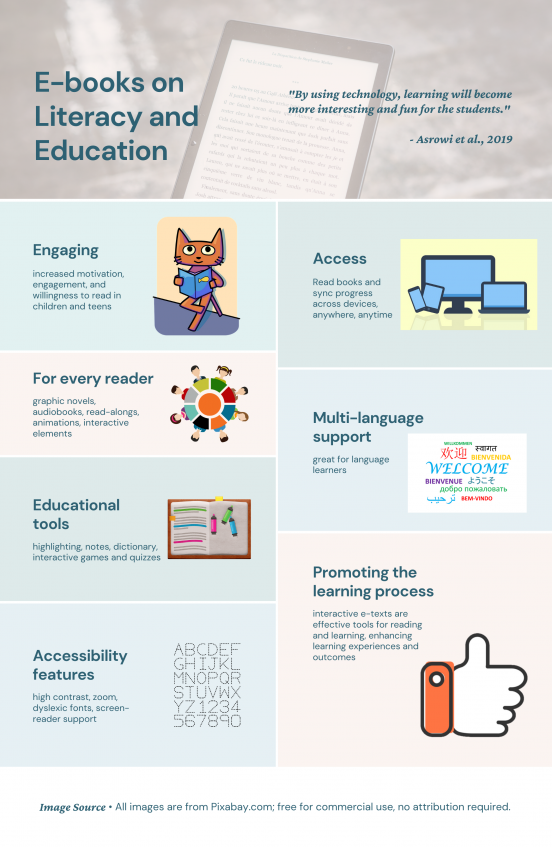Bibliography
Asrowi, A., Hadaya, A., & Hanif, M. (2019). The Impact of Using the Interactive E-Book on Students’ Learning Outcomes. International Journal Of Instruction, 12(2), 709-722. doi: 10.29333/iji.2019.12245a
Dore, R., Hassinger-Das, B., Brezack, N., Valladares, T., Paller, A., & Vu, L. et al. (2018). The parent advantage in fostering children’s e-book comprehension. Early Childhood Research Quarterly, 44, 24-33. doi: 10.1016/j.ecresq.2018.02.002
Fojtik, R. (2015). Ebooks and Mobile Devices in Education. Procedia – Social And Behavioral Sciences, 182, 742-745. doi: 10.1016/j.sbspro.2015.04.824
Fox, Leah C.C. (2014). Effects of Technology on Literacy Skills and Motivation to Read and Write. Education and Human
Development Master’s Theses, 522. http://digitalcommons.brockport.edu/ehd_theses/522
Ghaem Sigarchian, H., Logghe, S., Verborgh, R., de Neve, W., Salliau, F., & Mannens, E. et al. (2017). Hybrid e-TextBooks as comprehensive interactive learning environments. Interactive Learning Environments, 26(4), 486-505. doi: 10.1080/10494820.2017.1343191
Karovska Ristovska, A. (2018). Fonts for Improvement of the Reading Abilities in Persons with Dyslexia. Годишен Зборник На Филозофскиот Факултет/The Annual Of The Faculty Of Philosophy In Skopje, 71, 447-470. doi: 10.37510/godzbo1871447kr
Korat, O., & Falk, Y. (2017). Ten years after: Revisiting the question of e-book quality as early language and literacy support. Journal Of Early Childhood Literacy, 19(2), 206-223. doi: 10.1177/1468798417712105
Korucu, A., & Alkan, A. (2011). Differences between m-learning (mobile learning) and e-learning, basic terminology and usage of m-learning in education. Procedia – Social And Behavioral Sciences, 15, 1925-1930. doi: 10.1016/j.sbspro.2011.04.029
Laddusaw, S., & Brett, J. (2019). Dyslexia-friendly fonts: Using Open Dyslexic to increase exhibit access. College & Research Libraries News, 80(1), 33. doi: 10.5860/crln.80.1.33
McHugh, M., McCauley, V., Davison, K., Raine, R., & Grehan, A. (2020). Anchoring ocean literacy: participatory iBook design within secondary science classrooms. Technology, Pedagogy And Education, 29(1), 89-107. doi: 10.1080/1475939x.2020.1715241
Millar, M., & Schrier, T. (2015). Digital or Printed Textbooks: Which do Students Prefer and Why?. Journal Of Teaching In Travel & Tourism, 15(2), 166-185. doi: 10.1080/15313220.2015.1026474
Pabrua Batoon, M., Glasserman Morales, L., & Yanez Figueroa, J. (2018). Instructional Design to Measure the Efficacy of Interactive E-Books in A High School Setting. Turkish Online Journal Of Distance Education, 19(2), 47-60. doi: 10.17718/tojde.415641
Rvachew, S., Thompson, D., & Carolan, E. (2019). Description of Boys and Girls’ Nonverbal and Verbal Engagement With Electronic and Paper Books. Journal Of Cognitive Education And Psychology, 18(2), 212-222. doi: 10.1891/1945-8959.18.2.212
Sackstein, S., Spark, L., & Jenkins, A. (2015). Are e-books effective tools for learning? Reading speed and comprehension: iPad®i vs. paper. South African Journal Of Education, 35(4), 1-14. doi: 10.15700/saje.v35n4a1202
Sun, J., Flores, J., & Tanguma, J. (2012). E-Textbooks and Students’ Learning Experiences. Decision Sciences Journal Of Innovative Education, 10(1), 63-77. doi: 10.1111/j.1540-4609.2011.00329.x
Vorotnykova, I. (2019). Organizational, Psychological and Pedagogical Conditions for the Use of E-Books and e-Textbooks at School. Turkish Online Journal Of Distance Education, 89-102. doi: 10.17718/tojde.598227
Wauters, L., & Dirks, E. (2017). Interactive Reading with Young Deaf and Hard-of-Hearing Children in eBooks Versus Print Books. The Journal Of Deaf Studies And Deaf Education, 22(2), 243-252. doi: 10.1093/deafed/enw097

